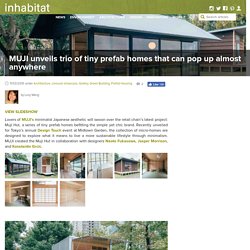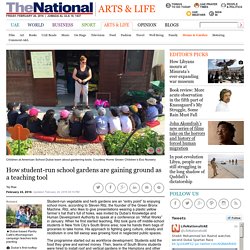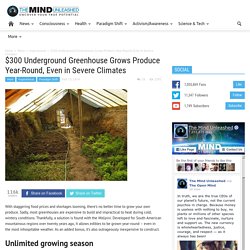

MUJI unveils trio of tiny prefab homes that can pop up almost anywhere. Lovers of MUJI’s minimalist Japanese aesthetic will swoon over the retail chain’s latest project: Muji Hut, a series of tiny prefab homes befitting the simple yet chic brand.

Recently unveiled for Tokyo’s annual Design Touch event at Midtown Garden, the collection of micro-homes are designed to explore what it means to live a more sustainable lifestyle through minimalism. MUJI created the Muji Hut in collaboration with designers Naoto Fukasawa, Jasper Morrison, and Konstantin Grcic. The temporary Muji Hut exhibition included Jasper Morrison’s ‘Hut of Cork,’ Konstantin Grcic’s ‘Hut of Aluminum,’ and Naoto Fukasawa’s ‘Hut of Wood.’ Each cozy building has a minimal lightweight footprint so that it can be easily moved and installed in a variety of locations. How student-run school gardens are gaining ground as a teaching tool. Student-run vegetable and herb gardens are an “entry point” to enjoying school more, according to Steven Ritz, the founder of the Green Bronx Machine.

Ritz, who likes to give presentations wearing a plastic yellow farmer’s hat that’s full of holes, was invited by Dubai’s Knowledge and Human Development Authority to speak at a conference on “What Works” in January. When he first started teaching, Ritz took guns off middle-school students in New York City’s South Bronx area; now he hands them bags of groceries to take home. — Virginia State University offers a look into its... This is What Happens When You Decide To Create Your Own Food Security - Grow Food, Not Lawns. If you’re fed up reading labels in the grocery store trying to find some real food that won’t kill you, I feel your pain.

Not to worry, there is a solution and it’s awesome. The truth is, you don’t need to depend on food corporations or the government to keep you healthy. Why would you want to anyways? All you need is a bit of space (provided you don’t live in a cave, in which case you’d have to settle on button mushrooms). Even if you have a small apartment or a small yard you can still grow quite a bit of food.
This used to be a lawn. It started with eight 6’x4′ raised beds with 1″x10″x10′ reclaimed redwood barn siding. The beds were lined with cardboard, sprayed down with a hose, and then filled with fresh compost. Many seeds were sown directly, some were germinated in a backyard hoop cloche. Setting up an irrigation system might be a little extra work, but it sure paid off quick! The pathways were covered in cardboard and wood chips.
Some beautiful arugula came first. Tomatillos. Urban Gardening: How to Build a Raised bed and Hoop House. $300 Underground Greenhouse Grows Produce Year-Round, Even in Severe Climates. With staggering food prices and shortages looming, there’s no better time to grow your own produce.

Sadly, most greenhouses are expensive to build and impractical to heat during cold, wintery conditions. Thankfully, a solution is found with the Walipini. Developed for South American mountainous regions over twenty years ago, it allows edibles to be grown year-round – even in the most inhospitable weather. As an added bonus, it’s also outrageously inexpensive to construct. Unlimited growing season Known as a pit or underground greenhouse, the Walipini utilizes the advantages of passive solar heating along with earth sheltering properties.
“The Walipini, in simplest terms, is a rectangular hole in the ground 6′ to 8′ deep covered by plastic sheeting. The Institute continues with an explanation of how the earth acts like a battery, storing heat during the day while releasing it during cooler nighttime temperatures: About the Author References for this article include: From Empty Lot to High-Tech Farm. Leonard Davis’ dream of urban farming grew from a seedling to a garden.

It’s located on the corner of East 130th Street and Arlington Avenue in the Glenville neighborhood. In 2008, Davis’ godfather allowed him to plant a garden on the large plot of land. In 2011, Davis bought the plot and gave away what he grew to anyone who wanted some. L-R: Leonard Davis, Jerome Pannell, Keneth Jackson and Mark Pannel with the seasonal high tunnel they erected March 10, 2013 on East 130 Street and Arlington. PHOTO by M. Now Davis’ garden has gone high-tech. Local teens and senior citizens originally helped Davis garden. Two neighbors, who were not on speaking terms, began to “communicate and develop bonds again” as they worked side by side in the garden, Davis said.
Their efforts yielded corn, watermelon, collard greens, cabbage, pole beans and snap beans. “It turned out perfect,” Davis added. Davis’ goal is to operate a for-profit garden and employ and train others, especially young people. Ron Finley: A guerilla gardener in South Central LA. Vast underground bomb shelter reappropriated by urban farmers. A network of tunnels 33 metres under Clapham in London, originally built as a WWII bomb shelter, is being used to grow a range of different salad vegetables destined for Londoners' plates.

This week, Wired.co.uk paid a visit to the subterranean farm, descending the winding steps deep into the bowels of southwest London. The space is enormous. It's made up of two seemingly never-ending tunnels (actually 430 metres long), lit -- at least during our visit -- only by the torches of Steven Dring and Richard Ballard, the founders of Zero Carbon Food, the company behind this agricultural curiosity.